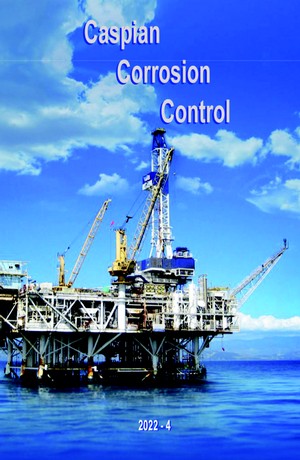Caspian Corrosion Control 2022
__________________________________________
K.İ.Matiyev, M.E.Alsafarova, Kh.İ.Hasanov, A.M.Samadov, Sh.Y.Aliyeva, A.Y.Suleymanova
«OilGasScientificResearchProject» Institute, SOCAR, Baku, Azerbaijan; Azerbaijan State Economic University, Baku, Azerbaijan
The deposition of asphaltenes, resins and paraffins (ASPs) is one of the important sources of oil sludge formation. The annual increase in the amount of oil sludge in the world creates an environmental problem. Therefore, the prevention of ASF deposits is an important issue from an environmental point of view. To solve this problem, an inhibitor has been developed to prevent the formation of ASPs. The proposed inhibitor reduces the pour point and viscosity of highly paraffinic oils. The developed inhibitor was investigated on NGDU oil. N.Narimanova in which the amount of paraffin exceeds 10.8%.
Keywords: Freezing point; Depressor efficiency; Kinematic viscosity
__________________________________________
Kh.I.Gasanov, Sh.H.Gasimov
«OilGasScientificResearchProject» Institute, SOCAR, Baku, Azerbaijan; Azerbaijan Medical University, Baku, Azerbaijan
The interaction of dithiodiethylamine (cystamine) (L1) with platinum compounds in non-aqueous and aqueous media has been studied. It is shown that in aqueous solutions, the L1 disulfide bond is cleaved, followed by platinum coordination of the resulting β-mercaptoethylamine (mercamine, HL). Depending on the reaction conditions, binuclear complexes of the composition [Pt2(LH)2C14] with bridged chlorine or sulfur atoms or [Pt2L2C12] with bridged chlorine atoms are formed. An X-ray diffraction analysis of the [Pt2(LH)2C14] (I) complex was carried out. Crystals I are rhombic, at 20 °C a=17.283(1), b=9.987(1), c=8.0187(9) Å; R=0.030. Molecule I is a binuclear complex in which platinum atoms are united by a pair of bridged thiolate ligands (-SCH2-CH2-NH+3). The metallocycle Pt2S2 is bent along the sulfursulfur line, so that the dihedral angle between the coordination planes of platinum atoms is 138°. The S-S distance equal to 2.909(1) Å is noticeably shorter than the doubled van- der- vaals radius of the sulfur atom (3.60 Å). The implementation of the reaction in benzene makes it possible to obtain a complex (L1H2)[PtX4] (X=C1, Вг) with the preservation of the sulfur-sulfur bond in the ligand. The structure of the complexes is confirmed by IR spectroscopy data.
Keywords: Platin; Bidentate ligand; Cystamine; Disulfide bond; Mercamine; Biological activity.
__________________________________________
A.M.Aliyev, M.G.Aliyeva, G.A.Ali-zade, Z.A.Shabanova
Institute of Catalysis and Inorganic Chemistry after M.Nagiev of ANAS, Baku, Azerbaijan; «OilGasScientificResearchProject» Institute, SOCAR, Baku, Azerbaijan;
The catalytic activity of modified natural clinptilolite zeolite has been studied in the oxidative dehydrogenation of methylcyclohexanol to ethylcyclohexanone. On the basic of experimental studies it was found that natural clinoptilolite modified with Cu2+ and Pd2+ cations exhibit high activity and selectivity in the reaction under con-sideration. Clinoptilolite containing 0.15 wt.% Pd2+ and 0.5 wt.% Cu2+ is the most ac-tive for the studied reaction. It was studied the kinetic regularities of the reaction over the selected catalyst. Based on literature material and own experimental data was suggested the stage scheme of the mechanism of the reaction and developed theoretically based kinetic model of the process.
Keywords: Methylcyclohexanol; Methylcyclohexanone; Oxidation; Zeolite; Mechanism; Kinetic model.
__________________________________________
Kh.Sh.Hajiahmedzadeh, E.T.Bagirova, I.V.Ahmadova
Institute of Catalysis and Inorganic Chemistry named after M.Nagiyev National Academy of Sciences of Azerbaijan, Baku, Azerbaijan
Destruction reactions are one of the most important reactions for high molecular weight compounds. They are also used to study the structure of highmolecular compounds, as well as to obtain low-molecular compounds from natural polymers (for example, glucose from cellulose and starch). During the destruction reactions, a decrease in the molecular weight is observed due to the breakdown (breaking) of the molecular chain without changing the chemical composition of the polymer. In this case, the functional groups located at the end of the macromolecule are not taken into account.
Keywords: Lewis acid; Polyolefin; Cation; Destruction; Free radical; Alkyl- radical; Carbocation.
__________________________________________
V.Sh.Aghayev
Institute of Catalysis and Inorganic Chemistry named after M.Nagiyev National Academy of Sciences of Azerbaijan, Baku, Azerbaijan
Synthetic and natural mordenite zeolites were decationized (DC) and dealuminized (DA) with different concentrations of HCl, and the catalyst samples were subjected to X-ray phase analysis. Over the samples of the catalyst was carried out the dismutation of toluene to benzene and xylene in the temperature range of 300-380 °C. It has been established that H-mordenite catalysts in the range SiO2/Al2O3 = 17-20 are more active and selective in the reaction under study conditions. It has been shown that synthetic mordenite zeolite has a higher activity than natural mordenite zeolite.
Keywords: Dismutation; Xylenes; Benzene; Zeolite; Mordenite; Space velocity.
__________________________________________
F.V.Aliyev
Institute of Catalysis and Inorganic Chemistry named after academician M.Naghiyev, Baku, Azerbaijan
The results of studies on the creation of highly dispersed metal zeolite systems and the study of their catalytic action in the oxidation of lower olefinic hydrocarbons (ethylene to acetaldehyde, propylene to acetone) are presented. It has been established that the selectivity of the action of these catalysts is determined by the optimal combination of the metal component in them with the acidity and structure of the zeolite. Based on the results of experimental studies of the kinetic regularities of the oxidation reactions of lower olefinic hydrocarbons on the synthesized catalysts, their probable stepwise mechanisms are presented and kinetic models of the reactions are developed.
Key words: Metallzeolite catalysts; Oxidation; Hydrocarbons.
__________________________________________




